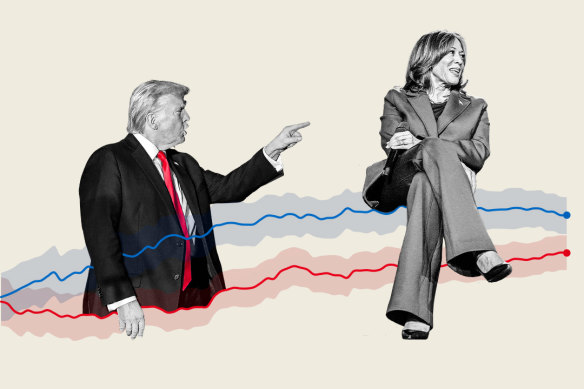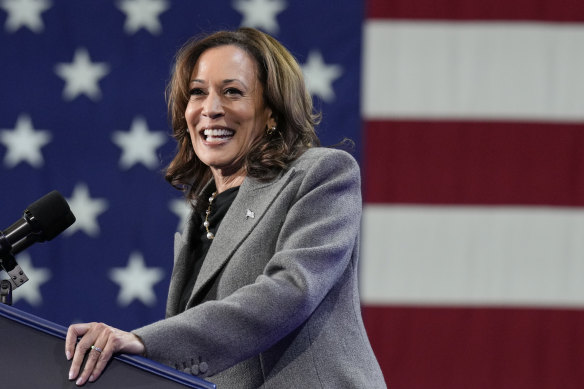This was published 7 months ago
Polls show movement towards Trump, but Harris has a bright spot
By Nate Cohn
New York: With two weeks to go, the polls of the US presidential election are starting to run out of room to get any closer.
Vice President Kamala Harris and former president Donald Trump are essentially tied – with neither candidate ahead by even a single point – in The New York Times’ polling average of five critical battleground states: Pennsylvania, Michigan, Nevada, Wisconsin and North Carolina.

With two weeks to go, there is nothing to split Donald Trump and Kamala Harris in the race to the White House.Credit: Marija Ercegovac
In North Carolina, Pennsylvania and Michigan, neither candidate “leads” by more than two-tenths of a percentage point. Neither can realistically win the presidency without winning at least one of these states.
With the polls so tight, the term “leads” really does need to be in quotation marks. Yes, the difference between “leading” or “trailing” by 0.2 points might feel very significant – it looks like the difference between whether a candidate is winning or losing. The election, however, is not decided by the polls; it’s decided by the voters. As a consequence, a lead or deficit of 0.2 points in a polling average is not the difference between whether a candidate is winning or losing, even though it may feel like it.
The polls simply are not precise enough for a 0.2-point edge to convey any meaningful information. For all purposes, the race is tied; don’t feel any sorrow or take any solace in whether your candidate is on the right or wrong side of that 0.2-point gap.
In recent elections, the polls have tended to systematically underestimate or overestimate one side by several percentage points. If that happens this year, either candidate could claim a surprisingly decisive victory.
Here’s where the race stands with two weeks to go.
Trump gains
Last week, we noted that the averages were tightening, but we were a little reluctant to say whether there was real movement. One or two good polls for Harris could have cancelled the tightening pretty quickly.
The past week’s polls made a clearer case for movement towards Trump.
Nationwide, Harris is now ahead by just 1 point in our average, her smallest lead since the Democratic convention. Most of the major national polls have shown a shift towards Trump since their prior surveys:
- Trump led by 2 points nationwide in a Fox News poll; Harris led by 2 points in its prior poll.
- Fairleigh Dickinson University found Harris ahead by 3 nationwide, while she led by 7 in its prior poll.
- Marquette Law School found a tied race, compared with a 6-point lead for Harris in August.
- Ipsos fielded several polls showing Harris up between 2 and 4 points over the past week, compared with leads of mostly 5 or 6 points in September.
- Emerson College found a tied race, compared with a 2-point lead for Harris in its prior poll.
There was only one major national poll showing Harris faring better this past week: the Marist poll, which showed her up 5 points nationwide, up from 2 points a few weeks ago. The YouGov/Economist poll showed no change; she’s still up by 4 points.
Together with the previous week’s polling, the balance of evidence suggests that Trump has gained some ground. The size of his gains shouldn’t be overstated – we’re talking about a point or so – but it has nonetheless been enough to make the race more or less truly tied. Whatever edge Harris might have had has vanished.
A Harris bright spot in North Carolina?
There’s only one state where the Times average has swung at least a point towards Harris: North Carolina.
This past week, a Quinnipiac poll found Harris ahead by 3 points, even as Trump held a wide lead in its survey of Georgia. And a Cygnal poll found Trump up by less than a point in North Carolina.
This is not necessarily a lot of evidence for a closer race. The next set of polls could bring better numbers for Trump and restore his lead.
But there is a plausible explanation for why North Carolina could be behaving somewhat differently than the rest of the country: Hurricane Helene.

Only one state has swung at least a point towards Kamala Harris: North Carolina. Credit: AP
At a minimum, the storm and recovery almost certainly kept the state focused on something other than the election in the past month. It’s also possible the response of candidates or the federal government left an impression on voters. Or maybe many in the reliably Republican western part of the state, which was ravaged by the storm, are less likely to take a telephone poll right now.
Whatever the explanation, all of this injects extra uncertainty into the state of play.
This article originally appeared in The New York Times.
Get a US election wrap-up every Tuesday plus a Thursday note from our foreign correspondents on what’s making news around the world. Sign up for our What in the world newsletter.